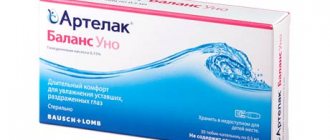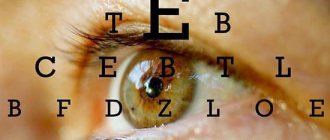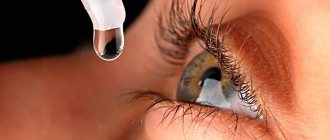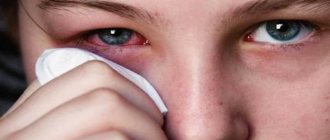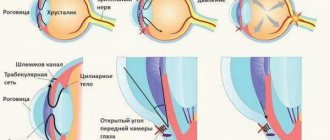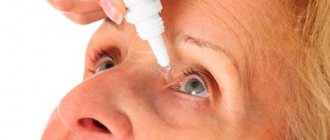The effectiveness of drops and vitamins for farsightedness
Farsightedness, or hypermetropia, often occurs in people over 40 years of age. At this time, the membranes of the eye lose their elasticity and cannot fully perform their functions. In order to stop pathological processes, doctors prescribe drops.
Even with optimal correction of farsightedness using glasses, some patients experience dry eyes and redness. To get rid of unpleasant sensations, you need drops that support the mucous membrane and prevent vision deterioration.
Will medications help?
Farsightedness is manifested not only by decreased visual acuity, but also by burning sensation, headache, and watery eyes. When a patient is diagnosed with hypermetropia, the doctor determines the most optimal way to increase visual acuity. The only way to completely get rid of the disease is through surgery. If the patient is not ready for surgery, then optical correction is used.
In addition to wearing glasses or contact lenses, experts recommend the use of special drops. Almost all drugs eliminate the following unpleasant symptoms:
- pain from eye strain;
- increased tearfulness;
- spasms that appear during overwork;
- rapid eye fatigue;
- rez.
If you regularly use drops prescribed by your doctor, presbyopia or farsightedness will stop progressing as intraocular pressure normalizes.
The same measures are recommended to be taken if there is a high risk of developing glaucoma.
Patients with farsightedness should understand that there is no universal drug that will eliminate all vision problems. Restoring vision using this method is possible only at an early stage of hypermetropia development. At the same time, the use of drops for farsightedness is necessary because they prevent the progression of the disease and eliminate associated symptoms.
List of the best drops
Drugs used for farsightedness significantly improve the quality of vision. They contain several active substances that complement each other. All of them are prescribed only by a doctor: their independent use threatens further deterioration of vision.
Taufon
These drops contain the active substance taurine. With age, the synthesis of this substance deteriorates. Action of Taufon drops:
- ensuring adequate nutrition of eye tissues;
- improvement of metabolism in the eye structures;
- maintaining normal functionality of cell membranes;
- strengthening the processes of restoration of affected tissues.
In order to normalize and improve vision, you need to undergo treatment with the drug at least 3 times a year. This requirement is especially relevant for those who work for a long time in front of a computer monitor. Taufon is also a good remedy for preventing pathologies associated with trauma or damage to the cornea.
It is usually recommended to take 1 drop four times a day. The course of therapy is from 1 to 1.5 months. The drug is prohibited for use during pregnancy and in patients under 18 years of age.
Taurine
Taurine is an effective drug based on a cysteine derivative - taurine. Indications are the same as for Taufon. Taurine prevents the formation of cataracts due to its retinoprotective effect. Reduces pressure inside the eye in open-angle glaucoma.
Instill 2-3 drops three times a day. The course of therapy with Taurine can be up to 3 months. It is prohibited to use drops to treat children. If necessary, it is repeated after a month's break. Do not use taurine drops for a long time to avoid irritation of the mucous membranes of the eyes.
Reticulin
The drug is used to improve vision in age-related farsightedness. Reticulin reduces the likelihood of disruption of the functionality of the cornea, lens and retina. Instillation of this drug into the eyes prevents the development of infections and prevents accommodation spasms.
What elements are needed to restore vision?
In order for the organs of vision to always function well, a sufficient amount of various nutrients is necessary. It is no secret that vitamins for the most part are not synthesized in the body, but come from the environment. It is very difficult to control whether they enter the body in sufficient quantities or not. Meanwhile, vitamins for vision in myopia and farsightedness are necessary for a variety of reactions and can act as both activators and catalysts in them. The most important for vision are:
- Vitamin A (retinol) and provitamin A (carotene). The scheme is as follows: products of plant origin supply a person with carotene, which is transformed into retinol in the body. This element gives a person the ability to distinguish colors and see at dusk. A deficiency of this vitamin can cause a disease such as “night blindness”, provoke dry eye syndrome, swelling of the eyelids, and redness of the sclera. Most of it is found in fish oil and carrots. Find out how to distinguish farsightedness from nearsightedness here.
- Vitamin B1 (thiamine) regulates metabolic processes in eye tissues. Another important function is the transmission of nerve impulses from the central nervous system to the eye and back. The deficiency causes insufficient passage of nerve impulses into the eye. The nutrition of the visual organs decreases, which is why the eyes quickly get tired, and dystrophy of all eye structures begins. Most of it is in beef liver and, oddly enough, in pasta.
- B2 (riboflavin). It is needed both to nourish the eye and to remove unnecessary substances from the membrane of the cornea and lens. Since these areas do not contain a network of blood vessels, their nutrition is carried out through diffuse processes. Normal metabolic processes are the key to active regeneration processes in the eyes. In addition to the above, B2 is needed in order to see in the dark and perceive colors. Its deficiency manifests itself in the development of conjunctivitis and photophobia. The main supplier of this element is milk and dairy products.
- C (ascorbic acid) is one of the most powerful natural antioxidants. It is necessary to protect the eye from the harmful effects of free radicals. This vitamin is the most effective remedy for preventing age-related vision loss, that is, farsightedness. This is due to maintaining the cornea in the correct anatomical condition. With the help of this vitamin, the condition of the eye vessels is maintained at the required level, and blood supply is normalized. This occurs by strengthening their walls, thereby reducing the risk of eye hemorrhages. Everyone knows that there is a lot of it in citrus fruits and berries.
- P (rutin) enhances the effect of vitamin C. If there is not enough of it, there may be frequent hemorrhages in the eye tissue due to the fragility of the eye vessels.
- D (calceferol) prevents age-related changes in the organs of vision and maintains the necessary visual acuity.
Vitamin D is important for regeneration and is excellent for treating inflammatory diseases.
- Lutein is, according to ophthalmologists, the most beneficial substance for the eyes. It is also not synthesized in the body, but comes from food (eggs, carrots, spinach, broccoli). A daily intake of at least 5 mg of lutein promotes normal eye function and prevents the development of pathologies and degenerative processes.
- Vitamin B6 is necessary to relieve tired eyes. The main symptom of a lack of this vitamin is involuntary twitching of the eyelid. It should enter the body in an amount of approximately 2 mg per day, its main source is vegetables, fish and meat.
- B12 – is responsible for the blood supply to the eyes. It is present in milk, fish and liver.
- Zinc is a very valuable trace element for the eyes; it can even prevent the development of cataracts. Comes with beef liver, fish and pumpkin. Find out how to choose the right glasses for farsightedness at this link.
Vitamin complexes
A modern person spends a lot of time on a computer, smartphone or tablet. All this significantly worsens vision. Vitamin complexes are used to relieve tension in the eye muscles. They soften the effects of visual overload and increase eye stability.
Vitamin therapy is indicated for those patients who wear contact lenses that correct farsightedness. The use of contact lenses is sometimes associated with irritation and dryness of the eyes. Drops containing vitamins help eliminate unwanted symptoms associated with wearing flexible optics.
Eye drops contain:
- carotene;
- folic acid;
- riboflavin;
- niacin;
- thiamine;
- cyanocobalamin;
- pyridoxine.
These drops cannot be used without a doctor’s permission, much less abused. The dosage must be selected correctly, because an excess of drugs is very harmful. When using drops with vitamins, it is recommended to take breaks, because if the eye tissues become saturated with active substances, they will cease to be active.
The following highly effective medications are recommended for the treatment of eye diseases:
- Kuspavit. These drops protect eye tissue from toxins and free radicals. They are recommended for hypermetropia and cataracts (as part of complex therapy). Kuspavit is also used to treat retinopathy and macular degeneration
- Zorro is a combination drug that includes vitamins and herbal extracts. The drug prolongs the functionality of the eyes and moisturizes the mucous membranes well. Eliminates burning, pain in the eyes, and their redness. It is used in cases where the patient feels “sandy” and suffers from increased sensitivity to bright light.
- Sante 40 are drops containing substances that are beneficial for the eyes - taurine, panthenol and tocopherol. Helps restore damaged cornea and other eye membranes. Drops are prescribed for symptoms of visual fatigue, accompanied by itching, redness, swelling, and a sharp decrease in visual acuity. With prolonged use, the pressure inside the eye is normalized.
- Oftan Katahrom are drops containing adenosine, ascorbic acid and cytochrome. They normalize local metabolism and tissue regeneration processes. Oftan Katahrom is an excellent means of preventing cataracts in patients with hypermetropia. When using drops, side effects are possible - irritation of the conjunctiva, nausea, feeling of lack of air, decreased blood pressure). The drug is contraindicated during pregnancy, breastfeeding and in case of hypersensitivity to the components.
- Vita-Iodurol is a drug prescribed for farsightedness and cataracts. Contains adenosine, nicotinic acid, vitamin PP, calcium. The drops improve metabolism in the lens and normalize the nutrition of eye tissue. The components of the medicine do not allow the deposition of protein substances in the cornea and lens.
- Quinax drops can fight cataract lesions. The drug is able to resolve small areas of lens clouding. Therapy with this drug is long-term and sometimes takes several years. Quinax can improve vision in hypermetropia and age-related presbyopia.
Review of effective remedies
Treatment of farsightedness requires an integrated approach. An ophthalmologist has several types of medications in his arsenal, combining them if necessary. Treatment is prescribed based on the prevailing symptoms.
It is not recommended to purchase and use eye drops on your own. Each drug has its own indications and contraindications; only a specialist can determine the need to prescribe them.
Taurine
The basis of this drug is an amino acid containing sulfur. With age, it disappears from the human body, which in particular leads to a deterioration in visual function.
Taurine cleanses blood vessels of cholesterol deposits and stimulates metabolic processes. “Taurine” is instilled twice a day, the duration of treatment is determined individually, but not less than 30 days. Cost about 40 rubles.
Taufon
Drops against farsightedness contain the substance taurine, an amino acid very necessary for the human body. Treatment with the drug helps restore metabolism in the eye tissues and improves visual function. “Taufon” eliminates discomfort, itching, burning of the eyes.
It is enough to instill “Taufon” twice a day, the duration of treatment is 1-3 months. If necessary, the course is repeated. The price of the drug is 100 rubles.
Emoxipin
Eye drops with angioprotective and antioxidant effects for farsightedness prevent the development of degenerative processes. They improve blood supply to the eye and prevent the formation of hemorrhages by strengthening the vascular wall.
Emoxipin is used in courses of 10 days, then a break for 2-3 months. The cost of the medicine is approximately 150 rubles.
Quinax
Specific drops used to treat eye cataracts. Promotes the resorption of protein deposits on the lens, increasing its transparency. Long-term use, for months. Instill 3-4 times a day. The cost of Quinax starts from 300 rubles.
Oftan-katachrome
Eye drops for farsightedness after 40 years. They have a complex composition:
- nicotinamide;
- adenosine phosphate;
- cytochrome C.
Has anti-inflammatory, antimicrobial, antioxidant effects. Instill one dose before bedtime. The duration of therapy is determined individually; it is usually prescribed to be used continuously. The cost starts from 300 rubles.
Vita-iodurol
Drops to restore vision containing a complex of vitamins and minerals:
- a nicotinic acid;
- calcium;
- adenosine phosphate;
- vitamin PP.
The drug improves energy metabolism and increases tissue nutrition. The use of Vita-iodurol prevents dystrophic changes in the lens caused by hypermetropia.
The medicine is instilled in the morning and evening, the duration of treatment is 1-2 months. Price - about 300 rubles.
Reticulin
The drug contains several plant extracts, adenosine phosphate. Drops effectively eliminate signs of age-related hypermetropia. Thanks to its composition, “Reticulin” relieves tension in the muscles responsible for accommodation.
Prescribed drops 2 times throughout the day, duration of treatment is 1-2 months. Price from 1000 rubles.
dietary supplements
For hypermetropia, dietary supplements are widely used. The main task of dietary supplements is to provide the body with all the necessary vitamins and microelements for the normal functioning of the visual organ.
The most effective dietary supplements for farsightedness:
- Okovit. The drug contains vitamins A, E, C, group B. As a result of treatment, the functioning of the retina improves and the composition of the vitreous body is normalized. Okovit prevents premature darkening of the lens. The medicine should be taken 2 times a day, 1 tablet for a month.
- Oculist - a supplement containing vitamin A, active substances of blueberries, dihydroquercetin. Indicated for farsightedness, as well as for visual impairment in poor lighting conditions. Capsules are taken 3 times a day for 3 weeks.
- Myrtilene is a dietary supplement based on blueberries. Improves blood supply to the retina and supports the functioning of the eye muscles. Patients taking Mirtilene note improved vision, relief from redness and pain in the eyes.
- Riboflavin is an eye drop that normalizes the condition of the eyes and prevents the development of complications with hypermetropia and cataracts. The product is instilled into the eyes 2 times a day.
- Focus is a supplement that improves near vision. The drug contains vitamins and microelements that are beneficial for the organ of vision. You should take these tablets once a day for a month.
Lutein: children's
Throughout the day, children's eyes are subject to high stress. Children learn about the world around them and reality through drawing, learn to write and read, and do homework. While performing all these activities, their vision undergoes great strain.
To ensure that children’s eyes are always healthy, it is important to initially wisely organize a gentle regime of study and proper rest. For this purpose, it is necessary to ensure regular consumption of eye vitamins for children. So, how to choose them and what should you take into account?
Today, the problem of farsightedness can be eliminated using various methods. This vision can be corrected using contact lenses or glasses, as well as laser surgery. Although such steps in no way exclude taking vitamins that can help fight the disease.
Overcoming myopia in a child is not very easy. This process takes a lot of time and must consist of a whole range of measures: the use of special glasses, regular vision exercises, special exercises, a balanced diet and taking the necessary medications. Taking vitamins for myopia is simply necessary.
Today, many special vitamin complexes have been developed for children with visual impairments, which should not be taken on their own. Parents should definitely consult their doctor, because he will tell you exactly which complex will be optimal for your child.
For myopia, it is important to consume foods containing vitamin A (retinol), which is necessary for the normal functioning of the retina and the transmission of impulses along the optic nerve. But you should know that retinol is only soluble in fats, so products with vitamin A should only be consumed with vegetable oil or butter.
Equally beneficial is the use of B vitamins:
- B1 normalizes the function of the optic nerves. B2 contributes to normal oxygen metabolism and nourishes the optic nerves. Its absence or deficiency is manifested by increased eye fatigue and redness of the eyelids. Vitamin B6 has a soothing effect on the eyes. It can also be used for the purpose of prevention.
Vitamin C is a powerful natural antioxidant that significantly strengthens the walls of blood vessels. Its use promotes proper blood circulation, as a result of which oxygen and useful substances are supplied to the organs of vision.
It is very useful to take calcium for myopia, which promotes the stability of the connective tissue of the eyes. After all, myopia is a consequence of the elongation of the eyeball.
Vitamins with this diagnosis should be taken for at least three months. After a thirty-day break, the course of treatment can be repeated. But it is better to consult your ophthalmologist for advice.
Content
The modern pharmacological market offers various so-called drugs. baby lutein. The content of the active substance in such medicines satisfies the need of the child's body for lutein.
Consumer Reviews
Irina: I used vitamin complexes against farsightedness - Myrtilene and Focus. I noticed an improvement in my vision from the third day: it became noticeably easier to read, and during visual work the feeling of fatigue and pain disappeared. The doctor helped me choose glasses that corrected my vision while reading.
Oleg: To improve vision at close range, I used Taufon eye drops. After a week of instillation I noticed some improvement. At the same time, the pain in the eyes and the feeling of sand during prolonged visual work disappeared.
What happens to the eyes with age-related farsightedness?
After forty years, many people begin to notice changes in visual acuity. Nearby objects seem blurry and indistinct, losing their usual outlines. To better view nearby objects, you need to move them away to a distance of about 25 cm. The eyes begin to get tired faster when reading, working at the computer, and unpleasant symptoms such as pain and tingling in the eyes are felt. Changes that occur with age-related farsightedness:
- the tone of the eye muscles is weakened;
- the corneal layer thickens;
- the lens becomes inelastic and loses its ability to change curvature.
All these signs indicate the development of age-related farsightedness - presbyopia. This disorder is associated with age-related changes in the human body. Unfortunately, they are irreversible, because the lens loses flexibility and elasticity, and by the age of 65-70 the accommodative abilities of the eye are lost.
Useful video
More useful and interesting information about eye medications for farsightedness can be found on the Internet pages
Drugs used for farsightedness help improve vision, relieve discomfort while wearing glasses, and prevent itching, pain and redness in the eyes. Like any other medicine, they should not be taken independently without a doctor's prescription. However, using the medications discussed above does not solve the cause of farsightedness. Wearing properly fitted glasses will help preserve your vision.
Author's rating
Author of the article
Alexandrova O.M.
Articles written
2031
about the author
Was the article helpful?
Rate the material on a five-point scale!
( 1 ratings, average: 5.00 out of 5)
If you have any questions or want to share your opinion or experience, write a comment below.
How to treat farsightedness in adults: laser therapy
Starting from the age of 18, when considering the question of how to cure farsightedness within 6 diopters, you can think about laser correction.
In this regard, the most popular techniques are LASIK and LASEK, as well as Super LASIK or, for example, EPI-LASIK. Don’t forget about PRK, i.e. photorefractive keratectomy.
Of course, any of these methods has certain characteristics, has its own indications, as well as contraindications. However, their essence is the same - to form a corneal surface with individual parameters.
Methods of vision correction
Restoring vision in case of farsightedness is carried out using three main methods:
- Glasses are the most popular way to correct deviations; in addition, they are the main way to correct farsightedness in children. But despite all the advantages, glasses bring a lot of inconvenience to a person - they often get dirty, sweat, slip, and interfere with sports and other vigorous activities. Also, glasses cannot provide complete vision correction; they limit lateral vision and spatial perception. The wrong choice of glasses causes rapid eye fatigue and progression of the disease.
- Contact lenses are commonly used to correct farsightedness, which is accompanied by low vision. At the same time, contact lenses produce a therapeutic effect, since the creation of a clear image in the fundus of the eye is the main stimulus for the development of vision. According to the doctor's testimony, contact lenses are allowed to be worn by adults and children, but many cannot quickly get used to a foreign object in the eyes, so the most common negative effect is allergic reactions and redness of the eyes.
- Laser treatment for vision correction for farsightedness is used only for adults and persons over 18 years of age.
Symptoms and diagnosis
Note that by the time the body’s growth is completely completed, the disease is farsighted in almost half of the people, while the other half has either emmetropia (normal refraction) or myopia.
Despite this fact, many farsighted individuals manage to completely compensate for the weakness of the refractive media of the ocular apparatus for quite a long time (for example, up to 35-40 years). This is achieved, as a rule, due to constant tension of the ciliary muscle of the organ of vision, which ensures that the lens is kept in a convex state, and this, as is known, increases its refractive power.
In the future, the ability to accommodate inevitably decreases, and by approximately 60 years the possibility of compensation is completely exhausted. As a result, we have a steady decrease in image clarity both when looking into the distance and when seeing objects close up.
https://www.youtube.com/watch?v=OnTZy0Z62cM
In this case, it is customary to talk about the so-called senile farsightedness, which, as mentioned above, is usually called presbyopia. Restoring vision with this type of farsightedness is possible only with the constant use of glasses with converging lenses. That is why, in relation to hypermetropia, the designation in plus (positive) diopters is used.
By the way, this fact is the answer for those people who are asking a question like: is farsightedness a plus or a minus?
It is also necessary to say that the development of hypermetropia is characterized by a condition such as aphakia. This is a congenital or acquired absence of the lens, most often associated with its removal (for example, during cataract surgery) or with injuries to this structure of the eye (for example, lens dislocation).
With the development of this condition, the refractive ability of the ocular media is greatly reduced. Visual acuity can be on the order of 0.1. In this case, correction with strong positive glasses or implantation of an intraocular lens is required.
The main sign of farsightedness is poor near vision with normal distance vision. This symptom is easily established by an ophthalmologist during a vision test using a Sivtsev table with letters of different sizes, as well as through the use of minus and plus lenses.
Instrumental diagnosis of farsightedness in children and adults involves the use of a phoropter and computer autorefractometry. The optical power of the cornea is measured using keratometry, and the length of the longitudinal axis of the eye is measured using echobiometry.
Farsightedness in children and young patients is checked only under conditions of forced dilation of the pupils with atropine sulfate. This method allows us to weaken the accommodation of the eye and facilitates the diagnosis of latent farsightedness.
An eye test chart is available in every eye office. This is the simplest method for identifying visual impairments.
During ophthalmoscopy, the doctor carefully examines the fundus, retina and optic nerve head. Computer refractometry allows you to evaluate the refractive properties of the cornea and lens.
In the process of echobiometry, the length of the eyeball, the thickness of the lens and the depth of the eye chamber are measured. Tonometry is used to measure intraocular pressure.
All these methods are non-contact and completely painless.
Sivtsev-Golovin table for visometry
What else can you do?
In addition to eye vitamins, to improve vision in hypermetropia, ophthalmologists recommend the use of special devices that train the eye muscle and improve blood supply to the eyeball and adjacent tissues. If previously this method of vision restoration was available only in specialized eye clinics (due to the bulkiness and high cost of the devices), now, with the development of technology, almost everyone can afford to purchase such devices for use at home - the devices have become compact and easy to use. use and affordable.
